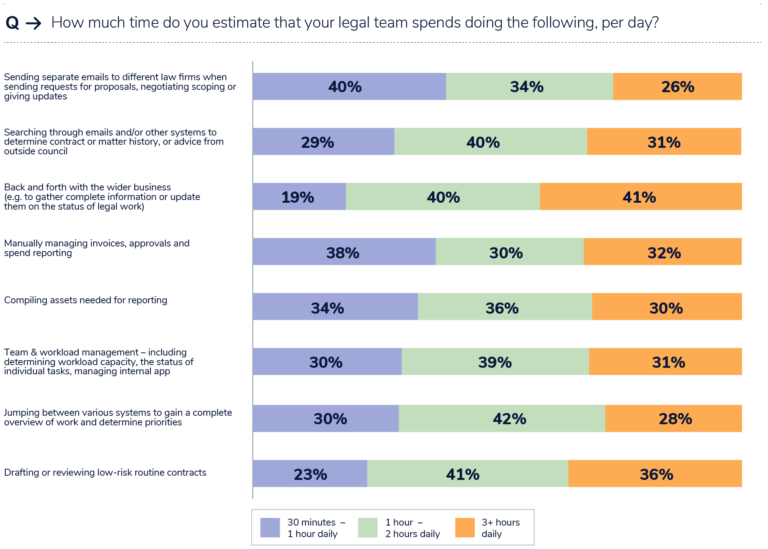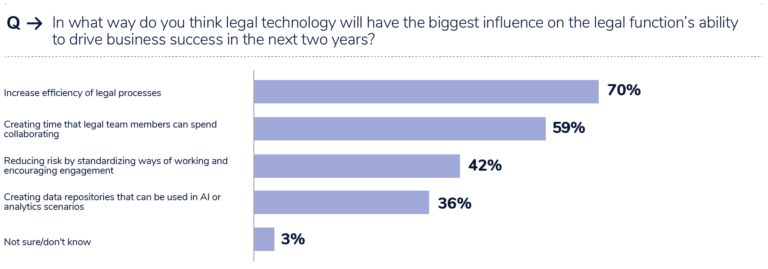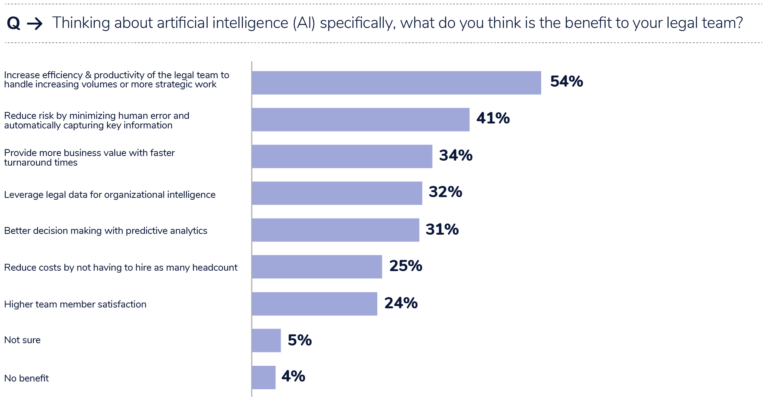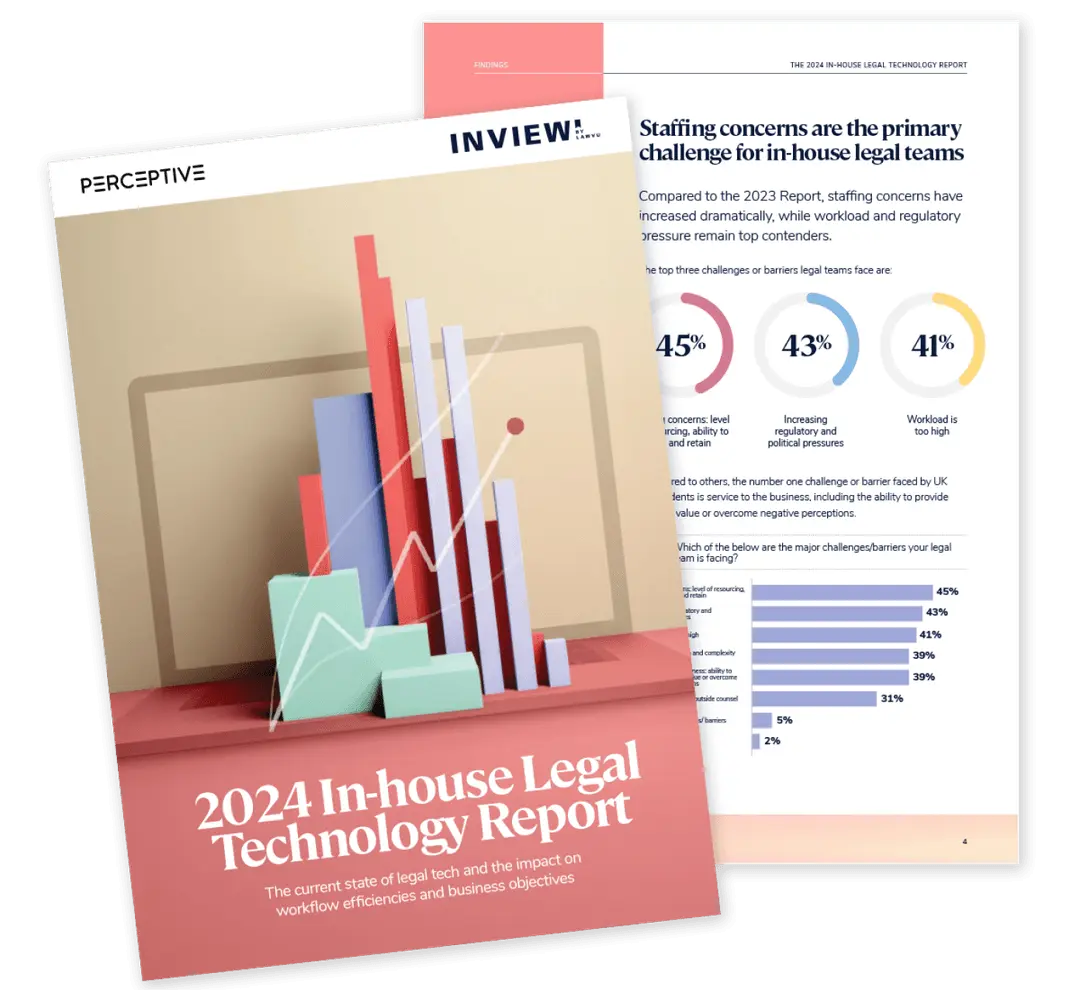Table Of Contents
About the Report
The 2024 In-House Legal Technology Report (“the Report”)* captures a detailed snapshot of the current landscape of in-house legal technology and its impact on business efficiencies and objectives. With perspectives gathered from over 300 in-house legal professionals across the United States, Australia, and the United Kingdom, the report reveals some of the biggest trends, challenges, and opportunities facing in-house legal teams today, and how emerging trends in legal technology are being leveraged to meet them.
The findings are designed to empower you by providing the data and insights you need to assess and compare your own adoption of in-house legal technology with industry peers, identify ways to address common challenges, consider strategies for best efficiency outcomes, and identify how strategic adoption of technology can best serve your business this year.
*The Report relies on the results of the survey conducted by Perceptive during October 2023. Click here for the survey methodology and demographics.
Key insights
1. Efficiency is the number one priority for in-house legal teams
With workloads on the rise, in-house legal teams are still spending a significant amount of time on manual administrative tasks, with 70 percent of respondents reporting that they spend more than an hour per day jumping between systems to gain a complete overview of work and to determine priorities.
With low-value work continuing to consume a disproportionate amount of in-house legal time and resources, it is no surprise that the primary goal for 58 percent of respondents is to increase the efficiency and productivity of their teams.
The report found that the top three time wasters were:
2. Staffing is the number one challenge facing in-house legal teams
We asked respondents about the biggest challenges and barriers facing their in-house legal teams - and staffing concerns clearly emerged as the top challenge faced this year. A hefty 45 percent of respondents report being concerned about staff resourcing levels, as well as the ability to hire and retain legal talent.
The 2024 survey also reflects the fast-evolving nature of the global legislative landscape, with legal teams reporting significant regulatory and political pressures this year. There are also unique challenges in the UK, where providing quality services to their businesses and overcoming negative perceptions of the internal legal function is the biggest challenge. This indicates that there is still work to be done in order for UK in-house legal teams to effectively streamline and demonstrate their internal value.
The report found that the top three challenges or barriers legal teams face are:
3. Administrative work remains a significant in-house burden
The Report reveals that in-house legal teams are still spending a significant amount of time on manual administrative tasks, compromising both business as usual and higher value work. The impact of this time loss is significant, with 77 percent of respondents of the view that time spent on manual daily activities detracts from their ability to work on larger business goals and deliver services in a timely manner.
However, this is only half of the story - excessive time spent on manual work also has a cost impact across the wider business. With the average cash salary of Senior Counsel in the USA sitting at USD $218,000 (2023 ACC Law Department Compensation Survey) an in-house legal team of ten people wasting three hours a day on administration could cost the business up to USD $817,500 per year.

4. Reliance on multiple legal technology tools causes pain points for legal teams
Despite a clear perception among respondents that consolidated solutions deliver clear efficiency gains, the fact remains that many teams continue to rely on multiple technology sources, with 42 percent currently utilizing four or more software vendors for their legal work. This figure is consistent with reports from 2023, with document management systems, eSignature tools, and spreadsheets all heavily utilized to manage reporting and day-to-day manual tasks.
This fragmented approach to legal technology is causing myriad pain points for legal teams. The biggest issues associated with current software usage all relate to problems associated with utilizing multiple tools - including time lost jumping between platforms, lack of integrations, and underuse of full functionalities.
The top three pain points with current workspace software offerings include:
5. AI and consolidated solutions are key to meeting efficiency and productivity priorities
With efficiency the main priority for in-house legal teams this year, the vast majority of respondents view legal technology as an enabler of business success.
With the Report revealing that productivity is the number one perceived benefit of both AI and full suite consolidated solutions, confidence is high that these two technologies are key to meeting efficiency and productivity priorities. The advantages of managing legal workflows under one roof are clearly acknowledged, with 17 percent of respondents considering consolidation to be a key factor in their choice of software.
AI in particular is now seen overwhelmingly as a positive thing for in-house legal teams, with only nine percent of respondents unconvinced of the benefits of machine learning tools. Responses show that AI is widely anticipated to become a tool for minimizing human error, capturing key information, and delivering faster turnaround times within corporate legal departments this year.


6. Adoption of in-house legal technology is on the rise - but there’s room for growth
The Report signals an overwhelming shift toward automated technology within in-house legal departments, with most now either utilizing AI or planning to do so in the next 12 months. UK teams are taking the lead when it comes to adoption, with 65 percent of UK teams already using AI tools for low-risk routine tasks.
However, with only 15 percent of respondents currently utilizing AI for complex use cases, there remains significant space for maturation in this space. The good news is that legal teams are aware of the opportunity, with 54 percent focused on gaining a better understanding of the capacity of AI to impact their processes this year.
With many teams still relying on multiple software solutions, significant opportunity also exists to consolidate tech stacks to optimize efficiency gains.
1. Efficiency is the number one priority for in-house legal teams
Recommendations
1. Prioritize efficiency for the benefit of the whole business - not just legal
The challenge
This year's survey has highlighted significant efficiency issues faced by in-house legal teams, with time spent on manual tasks detracting from their ability to deliver timely service and focus on larger business goals. With further challenges arising from staffing issues, regulatory pressures, and growing workloads, it is now more crucial than ever to take proactive steps to address these inefficiencies.
Recommendation
It’s important to first identify the losses associated with inefficient processes, such as too much back and forth with the business and wasted time bouncing between systems. Once understood, it’s possible to identify how legal tech can help with workflow consolidation, automation, self-service and insights. Improving the efficiency of the legal team will protect the interests of the wider business.
2. Cautiously expand the scope of your legal team’s AI use cases
The challenge
With 54 percent of participants identifying improved efficiency and productivity as the main advantage of AI, yet few applying it to complex use cases, there is a clear opportunity for internal legal teams to thoroughly reassess their current utilization of AI-powered technology. Overcoming security, privacy and ethics concerns will continue to be a challenge for legal teams.
Recommendation
When assessing AI use cases, it’s important to concentrate on workflows that are highly compatible with AI. It’s also critical to select technology providers who are leveraging AI to accelerate specific in-house workflows in a secure and private way. Moreover, dedicating time to upskilling is imperative to maximize the benefits of any new implementations.
3. There is a clear business case for legal teams to consolidate their tech stack
The challenge
Despite 53 percent of respondents perceiving efficiency and productivity to be the main benefit of full suite consolidated solutions, and 52 percent recognizing the same advantages for the wider business, adoption rates remain relatively low. This means legal teams continue to suffer inefficiencies caused by operating multiple platforms which lack integration.
Recommendation
When investing in legal technology, it’s worth considering a consolidated solution which mitigates the inefficiencies and security risks associated with multiple platforms. By adopting software which integrates as many of your legal workflows as possible, you are likely to see an improved ROI on your tech.
4. Focus on securing tech buy-in from stakeholders across your business
The challenge
Improving the efficiency of the legal department will benefit the wider business, with legal technology playing a pivotal role. However, securing buy-in from stakeholders can be challenging, underscoring the importance of showcasing the value of a solution not only to the legal department but also to the broader business.
Recommendation
Legal leaders should consider how they can best communicate the value of legal tech to the success of their organizations as a whole. Identifying how much time (and money) the legal function is losing on manual, low value tasks is a great place to start. This information can then be used to build a business case for a tech solution which can overcome these pain points and elevate legal’s impact on the organization’s bottom line.

